Alan Burnett
by Stu Hamilton
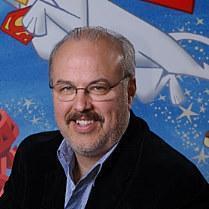 How
did you come to work on Batman: The Animated Series and what did
your duties include?
How
did you come to work on Batman: The Animated Series and what did
your duties include?
I was basically in charge of the stories.
In the mid-eighties when I worked for Hanna-Barbera I wrote a Batman
pilot for a Saturday morning series, which was deemed too adult for
kids. My boss at that time was Jean MacCurdy, who later went on to head
Warner Bros. Animation and became responsible for Tiny Toons,
Animaniacs, and a bunch of hit shows. When Warner Bros. decided to
do a Batman animated series, she came to me to be the writer-producer.
It took her three lunches to convince me that I could do the Batman show
I always wanted to do, so after being away from animation for awhile, I
decided to come back.
I was one of three producers. The others were Eric Radomski and Bruce
Timm. Their early Batman promo footage was a large part of why I came on
board. It was mesmerizing.
“Two-Face, Part One” features a heavy psychological storyline,
practically unheard of in animation at the time. The episode in question
is considered by many to be a huge turning point in the medium. Was
there ever any initial resistance to the story from outside or even
inside sources and do you additional comments to make about the episode?
There was no resistance whatsoever. Our crew and Fox network wanted to
push the envelope. I have always loved Two-Face. I think he’s on the
very top tier of villains in comic books, even though the number of
stories you can tell about him is probably limited. I always thought
that it was wrong that the accident that scarred his face created his
split personality. He had to have been that way before the scarring. So
that was the idea I was working on. I thought it was an original idea
for Two-Face, but I found out later that Andy Helfer had written a comic
story with that very same notion.
I consulted with a child psychiatrist to come up with a
kid-understandable reason why Harvey Dent developed a split personality,
and was surprised to find out that it doesn’t take much to start that
sickness going.
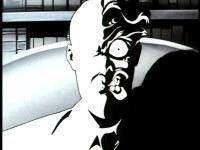 We didn’t want to reveal Harvey’s scarred face until the end of the
show, which presented the challenge of holding our audience’s attention
with a villain who had no costume or special accoutrements. He was just
a Suit, albeit a crazy one. Fortunately he was well acted in the
animation. Also, the director, Kevin Alteiri, bless his heart, figured
out a way to foreshadow the scarred face with lighting effects in a
scene in a psychiatrist’s office. We didn’t want to reveal Harvey’s scarred face until the end of the
show, which presented the challenge of holding our audience’s attention
with a villain who had no costume or special accoutrements. He was just
a Suit, albeit a crazy one. Fortunately he was well acted in the
animation. Also, the director, Kevin Alteiri, bless his heart, figured
out a way to foreshadow the scarred face with lighting effects in a
scene in a psychiatrist’s office.
That scene with the psychiatrist was central to me. It was the reason I
wrote the story. I had Zelda Rubinstein, the clairvoyant in
“Poltergeist,” in mind for the psychiatrist when I was writing, and our
voice director, Andrea Romano, brought her in to do the original
recording. When she hypnotizes Dent and releases the monster, I wanted
that moment when you’re thinking, “How the hell is she going to get out
of this?” And she simply snaps her fingers. It was a Hitchcock moment.
I’m a big Hitchcock fan, by the way. Big. There’s a picture of him in my
office above my desk. So it was a real kick to have John Vernon playing
Rupert Thorne. Vernon was Castro’s man in “Topaz,” and even though the
movie isn’t perfect, Vernon is. I can still see him shooting Karin Dor
and her dress billowing out over a checkerboard floor like a fallen
queen. Every once in a while we’d get a Hitchcock player for a Batman
recording – Roscoe Lee Browne, Tippi Hendron – and for me that was
always extra special.
Yourself, Randy Rogel and Paul Dini wrote "Riddler’s Reform." What
are the positives and negatives of working with so many writers on a
single episode? The Riddler himself is often described as a difficult
nut to crack – what are your thoughts on the prince of puzzles?
I don’t remember what the credits were on that show, but I think Paul
came up with the original notion, which he and I worked out in story,
and then Paul had to go on to something else, and Randy wrote the
script. But Randy could have been in at the outline stage, too. Who
knows? It all overlaps and melds after awhile.
Usually when one writer has written the story and another, the script,
it’s because the first writer had to go onto something else. It’s rare
when you have to switch writers because you don’t trust that the guy who
wrote the story can do justice to the script, but it happens.
As for the Riddler, he might be the worst Batman villain for TV, because
you always have to go through three steps with him. He presents a
riddle, the heroes have to solve it, and then have to stop the crime, at
which point usually another riddle pops up. And another solution is
discussed. And another crime is resolved. And it just goes on and on
until you catch him in the end. It’s redundant. And the riddles are
usually a play on words, so it gets talky, too.
“Riddler’s Reform” worked the best of all the Riddler stories because it
broke that chain. Riddler was giving riddles without even realizing it,
so the first step – presenting a riddle – was hidden. And most of the
riddles turned out to be visual. He wasn’t yapping his head off, like he
usually does.
By the way, may I do a little sidebar on my good friend Randy Rogel? We
met because he wrote not one, but two spec scripts for me the first year
of Batman: The Animated Series and was brought on staff soon
after. He’s a remarkable fellow. He graduated from West Point, was in
charge of several nukes for N.A.T.O. and then gave that all up for
musical theatre. He’s as prolific a songwriter as he is a script writer,
and after Batman he went on to write most of the songs for Animaniacs
including that song naming all the countries of the world to the
“Mexican Hat Dance” tune. He continues to write scripts and songs for
animation, as well as perform in live theatre. He’s toured all over the
nation in the Donald O’Connor part in “Singing in the Rain.” And now
he’s written a musical, which is in tryouts for Broadway, and I think is
going to make it. Randy’s a big physics buff, too, and attended a a
dinner party for Stephen Hawking a few months ago. Now there’s an
interview for you.
Okay, back to Batman.
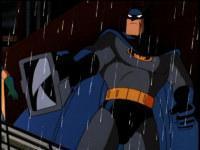 Cartoons were still very much a children’s medium at the time the
show originally aired – a few years prior, networks rarely allowed
superheroes to make a fist, never mind actually punch someone with it.
How was BS+P on the show and are there any occasions you recall that
especially hindered the show? Cartoons were still very much a children’s medium at the time the
show originally aired – a few years prior, networks rarely allowed
superheroes to make a fist, never mind actually punch someone with it.
How was BS+P on the show and are there any occasions you recall that
especially hindered the show?
The head of BS&P for the Fox network was a lovely woman named Avery
Coburn, who is the unsung hero of Batman: the Animated Series.
She knew what we were going after and gave us a lot of leeway, and when
we crossed the line, she helped us figure out solutions.
I’ll never forget - we had a story called “Perchance to Dream,” in which
Bruce Wayne realizes he’s trapped in a dream induced by the Mad Hatter,
and the only way he can get out of it is to startle himself so strongly
that he wakes up. To do this, he jumps off a bell tower in his dream
(and if the tower reminds you of the one in “Vertigo,” you now know
why). In essence, what Bruce has to do is commit suicide, which I dare
say is something rarely advocated in children’s programming. We were
okay up until the storyboard, which was pretty blunt about him jumping
off a building. (So was the script, but when you actually see it drawn…
ay-yi-yi!) Avery sat down with us and edited that section of the board
so that the jump became very abstract. Adults could easily read into it
what was happening, but to the little ones, it was as if he was leaping
into a cloud. We were extremely relieved to save this story, because it
was one of the best scripts of the run (written by Joe Lansdale).
And while I’m praising Avery, let me also give a big nod to Sidney
Iwanter, the Fox programmer at the time, who fought hard for serious,
realistic, dark stories. Early on, he and Avery both told me that the
upper hierarchy of Fox Television was expecting an Adam West-like
television series. They had no idea what they were in for. The result
was that Fox Children’s Programs created a new demographic for their
advertisers, 9 to 14-year-olds, which they continued with X-Men.
After the show reached its 65-episode mark, FOX insisted that the
show feature Robin in every episode. What did you think to his inclusion
in the show? Should Batman have a sidekick or does he work better as a
lone detective?
I don’t remember it as an edict from Fox although they did want to see
more of Robin. We certainly did stories without Robin beyond the first
65. But I like Robin. He provides an entry point in Batman for kids. The
world becomes more of a kids’ world. There’s nothing wrong with that.
We’re not talkin’ John Le Carre here. It’s Batman. But if I have to take
sides, I prefer Batman on his own with Alfred on the sidelines. Batman
has to talk with someone, right? It depends on the kind of story you’re
going for. The more serious the case, the better I like Batman alone.
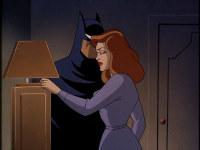 You came up with the storyline for the Mask of the Phantasm
feature. What made you decide to use an original villain rather than the
plethora of pre-existing Batman villains available to you, and what made
you focus on the romance as the main focal point of the film? You came up with the storyline for the Mask of the Phantasm
feature. What made you decide to use an original villain rather than the
plethora of pre-existing Batman villains available to you, and what made
you focus on the romance as the main focal point of the film?
I wanted the story to be about Bruce Wayne. We had touched very little
on Batman’s origin in the series, so that field was ripe for harvest. So
was his love life, or lack of it. I always knew his love was going to be
the villain, so that’s why we went with someone new.
Speaking of Batman romances, there were numerous ladies throughout
the shows – Talia, Catwoman, Wonder Woman, Zatanna, the list goes on.
What did you think of each of the relationships and how difficult is it
to write romances for a dark and brooding character such as Batman?
Batman’s great fun to tease. He’s been such a monk all his life -
re-channeling his sex drive to fight crime - he has no idea what do to
when a woman attracts him, even when she’s crawling all over him. This
is why Catwoman is his most enduring romance – she’s a criminal, so he
knows there’s no chance for a relationship. He really is nuts, you know.
When I let him win the girl at the end of “Mystery of the Batwoman,” it
was like a gift. “Here. Take her. Have sex. Get a life.”
Any stories you wanted to tell in the show but never got the chance
to?
Well, I would have liked to have gotten more into Batman’s sex life, but
of course that was impossible. At one point we wanted to do a story
without dialogue – “Silent Knight” we called it. Never happened. We also
wanted to do a Nocturna story – Bruce had drawn a hot model of her - but
she’s a vampire, which would’ve involved bloodletting, which was a huge
no-no for kids TV. I’m sure there were other stories we wanted to tell
that went by the wayside, but they don’t come to mind. We mostly got to
do what we wanted to do.
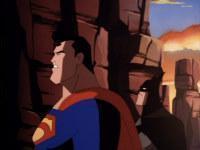 After the original run of Batman concluded, you went to work on
Superman: The Animated Series. The two would later meet up in the
3-part World’s Finest storyline, widely regarded as one of the show’s
best stories. What thought process went into their first meeting and
what do you think to the final result? After the original run of Batman concluded, you went to work on
Superman: The Animated Series. The two would later meet up in the
3-part World’s Finest storyline, widely regarded as one of the show’s
best stories. What thought process went into their first meeting and
what do you think to the final result?
I’m very proud of that story, because it was a hard nut to crack. First,
it was a three-part episode that we wanted to feel like a movie. We knew
that was how it would probably premiere on the WB – as a movie. Second,
Batman and Superman are oil and vinegar. One’s mortal, one’s a god. They
don’t belong in the same frame together, let alone the same story. So
that took work. The key to the story was that they didn’t like each
other, which lead to a ménage a quatre, as one critic put it: Lois and
Clark, Lois and Superman, Lois and Bruce, and Lois and Batman. It turned
out to be great fun, and we were blessed with the tremendous talents at
Tokyo Movie Shinsha, which animated all three parts. The animated acting
is superlative, and if that didn’t work, we wouldn’t be talking about
this show today.
The New Batman Adventures offered you the rare opportunity to
revisit Batman and make any necessary revamps to the characters
personalities and well as their visuals. Were there any characters you
thought in particular needed revamping and how successful a job do you
think you did?
I don’t think we revamped any of the characters to any major extent,
though we might have done some shadings on Bruce’s voice, making him a
little closer to Batman. It was Bruce Timm who revamped the look, making
the models more angular and slender. I loved the new look.
Batman or Superman – Pick one!
Batman, d’uh.
Which episodes do you consider you’re favorites and which do you like
the least?
There are a surprising number I like. I have a fondness for “Perchance
to Dream”, because it digs deeply into the Batman legend. You would be
hard put to tell that story with another superhero. I saw “Read My Lips”
not long ago, the first Ventriloquist story, also written by Joe
Lansdale, and it was so noir-ish you felt as if you could bite the air.
And then there’s “Almost Got ‘im,” “Heart of Ice,” “Robin’s Reckoning,”
and others. As for the ones I least like, well, I’d rather not say. I
was the one who started everyone down the wrong path, so no one credited
should get the blame. You win some, you lose some.
Batman eventually grew into a bitter old man in Batman Beyond,
to be replaced by a teenager. What was your initial reaction to
Batman Beyond and how do you think the show holds up?
Well, once we figured out how a teenage Batman could work, I thought it
wouldn’t suck. Looking back, it holds up pretty well. I understand the
comics might even feature him again. He seems to have been accepted as a
valid continuation of the Batman legend. So, I’m happy with him.
Is there any villain you would’ve liked to use again in the future
Batman Beyond timeline but never got around to doing?
I don’t remember any burning desire in that area.
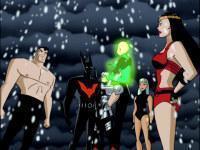 Most consider
"The Call" to be a fun story, but filled with numerous
plot holes, especially in its latter half. Any comments on the story or
the Justice League Unlimited themselves? Most consider
"The Call" to be a fun story, but filled with numerous
plot holes, especially in its latter half. Any comments on the story or
the Justice League Unlimited themselves?
I’m glad you asked me about “The Call.” There seems to be a minor rift
in the cosmos about that one. All I can tell you is I don’t remember the
script not making sense.
You’ve worked on various different versions of Batman – the original
incarnation, the revamped Dark Knight in The New Batman Adventures,
Batman as a teenager, Batman as a bitter old man and now in a separate
continuity with The Batman. Which do you prefer and which is your
least favorite?
I like them all, but have a particular fondness for the original in “B:TAS”.
You know what they say – you never forget the first time.
My least favorite Batman we didn’t do. That would be Batman with Batmite.
[Alan shudders.]
What can we expect from The Batman season five?
It’s the year of the super team-ups. I’ve seen final cuts on the
two-part Batman/Superman team-up and I’m very happy with them. Hearing
Dana Delaney, Clancy Brown and George Newbern’s voices coming out of our
models was a blast to the past for me. Then down the road, as has been
reported, you’ll see GA and GL and Flash and Hawkman and the Martian
again. There are also a few straight Batman stories, including a couple
wild Joker tales. There’s one called “Joker Express,” written by Brian
Swenlin, which does for subways what Keaton’s “The General” did for
trains, and I’m rather eager to see how that turns out. All in all, I
think kids will be in for a good time in Gotham this year.
The World’s Finest would like to thank Alan Burnett for his
participation in this Q & A.
[ Back to Backstage ]
|